Tribological and Thermo-Mechanical Properties of TiO2 Nanodot-Decorated Ti3C2/Epoxy Nanocomposites
Abstract
:1. Introduction
2. Materials and Methods
2.1. Materials
2.2. Preparation of Ti3C2 Microparticles
2.3. Preparation of TiO2 Decorated Ti3C2 (TiO2/Ti3C2) Composite Particles
2.4. Preparation of TiO2/Ti3C2/Epoxy Nanocomposites
2.5. Characterization and Measurement
3. Results
3.1. Surface Morphology of TiO2/Ti3C2 Microparticles
3.2. XRD and FTIR Analysis of TiO2/Ti3C2 Composite Particles
3.3. Determining the Optimal Mass Fraction of TiO2/Ti3C2 through Testing the Tribological Properties of 0.25 M TiO2/Ti3C2/Epoxy Nanocomposite
3.4. Fracture Surface Analysis of TiO2/Ti3C2/Epoxy Nanocomposites with Different TiO2/Ti3C2
3.5. Surface Morphology of TiO2/Ti3C2/Epoxy Nanocomposites with Different TiO2/Ti3C2 before Friction Tests
3.6. Tribological Properties of TiO2/Ti3C2/Epoxy Nanocomposites with Different TiO2/Ti3C2
3.7. Worn Surface Analysis of TiO2/Ti3C2/Epoxy Nanocomposites with Different TiO2/Ti3C2
3.8. Dynamic Mechanical Analysis of Ti3C2/Epoxy Nanocomposites with Different TiO2/Ti3C2
3.9. A Proposed Mechanism for the Improved Tribological and Thermo-Mechanical Properties of TiO2/Ti3C2/Epoxy Nanocomposites
4. Conclusions
Author Contributions
Funding
Institutional Review Board Statement
Informed Consent Statement
Data Availability Statement
Conflicts of Interest
References
- Gong, L.X.; Zhao, L.; Tang, L.; Liu, H.Y.; Mai, Y.W. Balanced electrical, thermal and mechanical properties of epoxy composites filled with chemically reduced graphene oxide and rubber nanoparticles. Compos. Sci. Technol. 2015, 121, 104–114. [Google Scholar] [CrossRef]
- Domun, N.; Hadavinia, H.; Tao, Z.; Sainsbury, T.; Vahid, S. Improving the fracture toughness and the strength of epoxy using nanomaterials-a review of the current status. Nanoscale 2015, 7, 10294–10329. [Google Scholar] [CrossRef] [PubMed] [Green Version]
- Jandt, K.D.; Sigusch, B.W. Future perspectives of resin-based dental materials. Dent. Mater. 2009, 25, 1001–1006. [Google Scholar] [CrossRef]
- Zewde, B.; Pitliya, P.; Raghavan, D. The role of surface modified TiO2 nanoparticles on the mechanical and thermal properties of CTBN toughened epoxy nanocomposite. J. Mater. Sci. 2016, 51, 9314–9329. [Google Scholar] [CrossRef]
- Sakka, M.M.; Antar, Z.; Elleuch, K.; Feller, J.F. Tribological response of an epoxy matrix filled with graphite and/or carbon nanotubes. Friction 2017, 5, 171–182. [Google Scholar] [CrossRef]
- Ai, D.; Mo, R.B.; Wang, H.H.; Lai, Y.B.; Jiang, X.; Zhang, X.Y. Preparation of waterborne epoxy dispersion and its application in 2K waterborne epoxy coatings. Prog. Org. Coat. 2019, 136, 105258. [Google Scholar] [CrossRef]
- Liu, S.L.; Fan, X.S.; He, C.B. Improving the fracture toughness of epoxy with nanosilica-rubber core-shell nanoparticles. Compos. Sci. Technol. 2016, 125, 132–140. [Google Scholar] [CrossRef]
- Esteves, M.; Ramalho, A.; Ferreira, J.A.M.; Nobre, J.P. Tribological and mechanical behaviour of epoxy/nanoclay composites. Tribol. Lett. 2013, 52, 1–10. [Google Scholar] [CrossRef]
- Bazrgari, D.; Moztarzadeh, F.; Sabbagh-Alvani, A.A.; Rasoulianboroujeni, M.; Tahriri, M.; Tayebi, L. Mechanical properties and tribological performance of epoxy/Al2O3 nanocomposite. Ceram. Int. 2018, 44, 1220–1224. [Google Scholar] [CrossRef]
- Milad, K.; Soheil, S.; Mohammad, A.; Uttandaraman, S. Structural characterization of CVD custom-synthesized carbon nanotube/polymer nanocomposites in large-amplitude oscillatory shear (LAOS) mode: Effect of dispersion characteristics in confined geometries. Macromolecules 2019, 52, 1489–1504. [Google Scholar]
- Chakraborty, H.; Sinha, A.; Mukherjee, N.; Ray, D.; Chattopadhyay, P.P. A study on nanoindentation and tribological behaviour of multifunctional ZnO/PMMA nanocomposite. Mater. Lett. 2013, 93, 137–140. [Google Scholar] [CrossRef]
- Shen, J.T.; Top, M.; Pei, Y.T.; De Hosson, J.T.M. Wear and friction performance of PTFE filled epoxy composites with a high concentration of SiO2 particles. Wear 2015, 322, 171–180. [Google Scholar] [CrossRef]
- Pan, G.L.; Guo, Q.; Ding, J.; Zhang, W.D.; Wang, X.M. Tribological behaviors of graphite/epoxy two-phase composite coatings. Tribol. Int. 2010, 43, 1318–1325. [Google Scholar] [CrossRef]
- Shen, X.J.; Pei, X.Q.; Fu, S.Y.; Friedrich, K. Significantly modified tribological performance of epoxy nanocomposites at very low graphene oxide content. Polymer 2013, 54, 1234–1242. [Google Scholar] [CrossRef]
- Haba, D.; Barbezat, M.; Ayalur-Karunakaran, S.; Schlögl, S.; Brunner, A.J.; Pinter, G. Significance of epoxy network properties for the toughening effect of flaky and fullerene-like WS2 nanoparticles. J. Polym. Sci. Part B Polym. Phys. 2016, 54, 1738–1747. [Google Scholar] [CrossRef]
- Gafsi, N.; Smaoui, I.; Verdejo, R.; Kharrat, M.; Dammak, M. Tribological and mechanical characterization of epoxy/graphite composite coatings: Effects of particles’ size and oxidation. Proc. Inst. Mech. Eng. Part J J. Eng. Tribol. 2020, 235, 129–137. [Google Scholar] [CrossRef]
- Shi, Y.J.; Mu, L.W.; Feng, X.; Lu, X.H. The tribological behavior of nanometer and micrometer TiO2 particle-filled polytetrafluoroethylene/polyimide. Mater. Des. 2011, 32, 964–970. [Google Scholar] [CrossRef]
- Javidparvar, A.A.; Ramezanzadeh, B.; Ghasemi, E. Effects of surface morphology and treatment of iron oxide nanoparticles on the mechanical properties of an epoxy coating. Prog. Org. Coat. 2016, 90, 10–20. [Google Scholar] [CrossRef]
- Malucelli, G.; Palmero, P.; Ronchetti, S.; Delmastro, A.; Montanaro, L. Effect of various alumina nano-fillers on the thermal and mechanical behaviour of low-density polyethylene-Al2O3 composites. Polym. Int. 2010, 59, 1084–1089. [Google Scholar]
- Fernandez, M.J.J.; Abirami, K.; Swetha, S.; Soundarya, S.; Jayanarayanan, K. The effect of nano, micro and dual scale filler reinforcement on the morphology, mechanical and barrier properties of polypropylene composites. Mater. Today 2020. [Google Scholar] [CrossRef]
- Weng, L.; Wang, X.M.; Zhang, X.R.; Guan, L.Z.; Zhang, H. The effects of morphology of Ag@SiO2 core-shell nanoparticles on the dielectric properties and mechanical properties of polyvinylidene difluoride based nanocomposite. Nanosci. Nanotechnol. Lett. 2019, 11, 923–930. [Google Scholar] [CrossRef]
- Zheng, L.; Zhong, Y.H.; Gao, Y.H.; Li, J.Y.; Zhang, Z.H.; Liu, Z.N.; Ren, L.Q. Coupling effect of morphology and mechanical properties contributes to the tribological behaviors of snake scales. J. Bionic Eng. 2018, 15, 481–493. [Google Scholar] [CrossRef]
- Zhong, Y.J.; Wu, Z.G.; Tang, Y.; Xiang, W.; Guo, X.D.; Zhong, B.H. Micro-nano structure Na2MnPO4F/C as cathode material with excellent sodium storage properties. Mater. Lett. 2015, 145, 269–272. [Google Scholar] [CrossRef]
- Zhang, Y.Q.; Guo, B.S.; Hu, L.Y.; Xu, Q.J.; Li, Y.; Liu, D.Y.; Xu, M.W. Synthesis of SnS nanoparticle-modified MXene (Ti3C2Tx) composites for enhanced sodium storage. J. Alloys Compd. 2018, 732, 448–453. [Google Scholar] [CrossRef]
- Naguib, M.; Kurtoglu, M.; Presser, V.; Lu, J.; Niu, J.; Min, H.; Hultman, L.; Gogotsi, Y.; Barsoum, M.W. Two-dimensional nanocrystals produced by exfoliation of Ti3AlC2. Adv. Mater. 2011, 23, 4248–4253. [Google Scholar] [CrossRef] [Green Version]
- Zhang, H.; Wang, L.; Chen, Q.; Ping, L.; Hu, Q. Preparation, mechanical and anti-friction performance of MXene/polymer composites. Mater. Des. 2016, 92, 682–689. [Google Scholar] [CrossRef]
- Tang, B.L.; Yang, Y.R.; Shi, Y.C.; Nie, H.J.; Xia, H.Q.; Shen, X.J. Improved mechanical performances of short aramid fiber-reinforced polypropylene composites by Ti3C2 Mxene nanosheets. Polym. Compos. 2021, 42, 2010–2018. [Google Scholar] [CrossRef]
- Chen, X.; Zhao, Y.; Li, L.; Wang, Y.; Yu, J. MXene/polymer nanocomposites: Preparation, properties, and applications. Polym. Rev. 2021, 61, 80–115. [Google Scholar] [CrossRef]
- Chang, L.; Zhang, Z.; Breidt, C.; Friedrich, K. Tribological properties of epoxy nanocomposites I. Enhancement of the wear resistance by nano-TiO2 particles. Wear 2005, 258, 141–148. [Google Scholar] [CrossRef]
- Shao, X.; Liu, W.M.; Xue, Q.J. The tribological behavior of micrometer and nanometer TiO2 particle-filled poly(phthalazine ether sulfone ketone) composites. J. Appl. Polym. Sci. 2004, 92, 906–914. [Google Scholar] [CrossRef]
- Zhang, Z.; Yang, M.; Yuan, J.; Guo, F.; Men, X. Friction and wear behaviors of MoS2-multi-walled-carbonnanotube hybrid reinforced polyurethane composite coating. Friction 2019, 7, 316–326. [Google Scholar] [CrossRef] [Green Version]
- Xuan, J.; Wang, Z.Q.; Chen, Y.; Liang, D.J.; Cheng, L. Organic-base-driven intercalation and delamination for the production of functionalized titanium carbide nanosheets with superior photothermal therapeutic performance. Angew. Chem. Int. Ed. 2016, 55, 14569–14574. [Google Scholar] [CrossRef]
- Ahmed, B.; Anjum, D.H.; Gogotsi, Y.; Alshareef, H.N. Atomic layer deposition of SnO2 on MXene for Li-ion battery anodes. Nano Energy 2017, 34, 249–256. [Google Scholar] [CrossRef] [Green Version]
- Mashtalir, O.; Naguib, M.; Mochalin, V.N.; Dall’Agnese, Y.; Min, H.; Barsoum, M.W.; Gogotsi, Y. Intercalation and delamination of layered carbides and carbonitrides. Nat. Commun. 2013, 4, 1716–1723. [Google Scholar] [CrossRef] [PubMed]
- Zhu, J.F.; Tang, Y.; Yang, C.H.; Wang, F.; Cao, M.J. Composites of TiO2 nanoparticles deposited on Ti3C2 MXene nanosheets with enhanced electrochemical performance. J. Electrochem. Soc. 2016, 163, A785–A791. [Google Scholar] [CrossRef]
- Rashad, M.M.; Elsayed, E.M.; Al-Kotb, M.S.; Shalan, A.E. The structural, optical, magnetic and photocatalytic properties of transition metal ions doped TiO2 nanoparticles. J. Alloys Compd. 2013, 581, 71–78. [Google Scholar] [CrossRef]
- Huang, D.G.; Liao, S.J.; Quan, S.Q.; Liu, L.; He, Z.J.; Wan, J.B.; Zhou, W.B. Preparation of anatase F doped TiO2 sol and its performance for photodegradation of formaldehyde. J. Mater. Sci. 2007, 42, 8193–8202. [Google Scholar] [CrossRef]
- Meng, F.; Zhang, Z.; Gao, P.; Kang, R.; Liu, T. Excellent tribological properties of epoxy-Ti3C2 with three-dimensional nanosheets composites. Friction 2020, 284, 734–746. [Google Scholar] [CrossRef]
- Friedrich, K.; Flock, J.; Varadi, K.; Neder, Z. Experimental and numerical evaluation of the mechanical properties of compacted wear debris layers formed between composite and steel surfaces in sliding contact. Wear 2001, 251, 1202–1212. [Google Scholar] [CrossRef]
- Xue, M.Q.; Wang, Z.P.; Yuan, F.; Zhang, X.H.; Wei, W.; Tang, H.; Li, C.S. Preparation of TiO2/Ti3C2Tx hybrid nanocomposites and their tribological properties as base oil lubricant additives. RSC Adv. 2017, 7, 4312–4319. [Google Scholar] [CrossRef] [Green Version]
- Aghamohammadi, H.; Heidarpour, A.; Jamshidi, R.; Bayat, O. Tribological behavior of epoxy composites filled with nanodiamond and Ti3AlC2-TiC particles: A comparative study. Ceram. Int. 2019, 45, 9106–9113. [Google Scholar] [CrossRef]
- Kurdi, A.; Chang, L. Comparative tribological and mechanical property analysis of nano-silica and nano-rubber reinforced epoxy composites. Appl. Mech. Mater. 2018, 875, 53–60. [Google Scholar]
- Cao, Y.; Deng, Q.H.; Liu, Z.D.; Shen, D.Y.; Wang, T.; Huang, Q.; Du, S.Y.; Jiang, N.; Lin, T.C.; Yu, J.H. Enhanced thermal properties of poly(vinylidene fluoride) composites with ultrathin nanosheets of MXene. RSC Adv. 2017, 7, 20494–20501. [Google Scholar] [CrossRef] [Green Version]
- Ganguli, S.; Roy, A.K.; Anderson, D.P. Improved thermal conductivity for chemically functionalized exfoliated graphite/epoxy composites. Carbon 2008, 46, 806–817. [Google Scholar] [CrossRef]
- Ghosh, P.; Pathak, A.; Goyat, M.; Halder, S. Influence of nanoparticle weight fraction on morphology and thermal properties of epoxy/TiO2 nanocomposite. J. Reinf. Plast. Compos. 2012, 31, 1180–1188. [Google Scholar] [CrossRef]

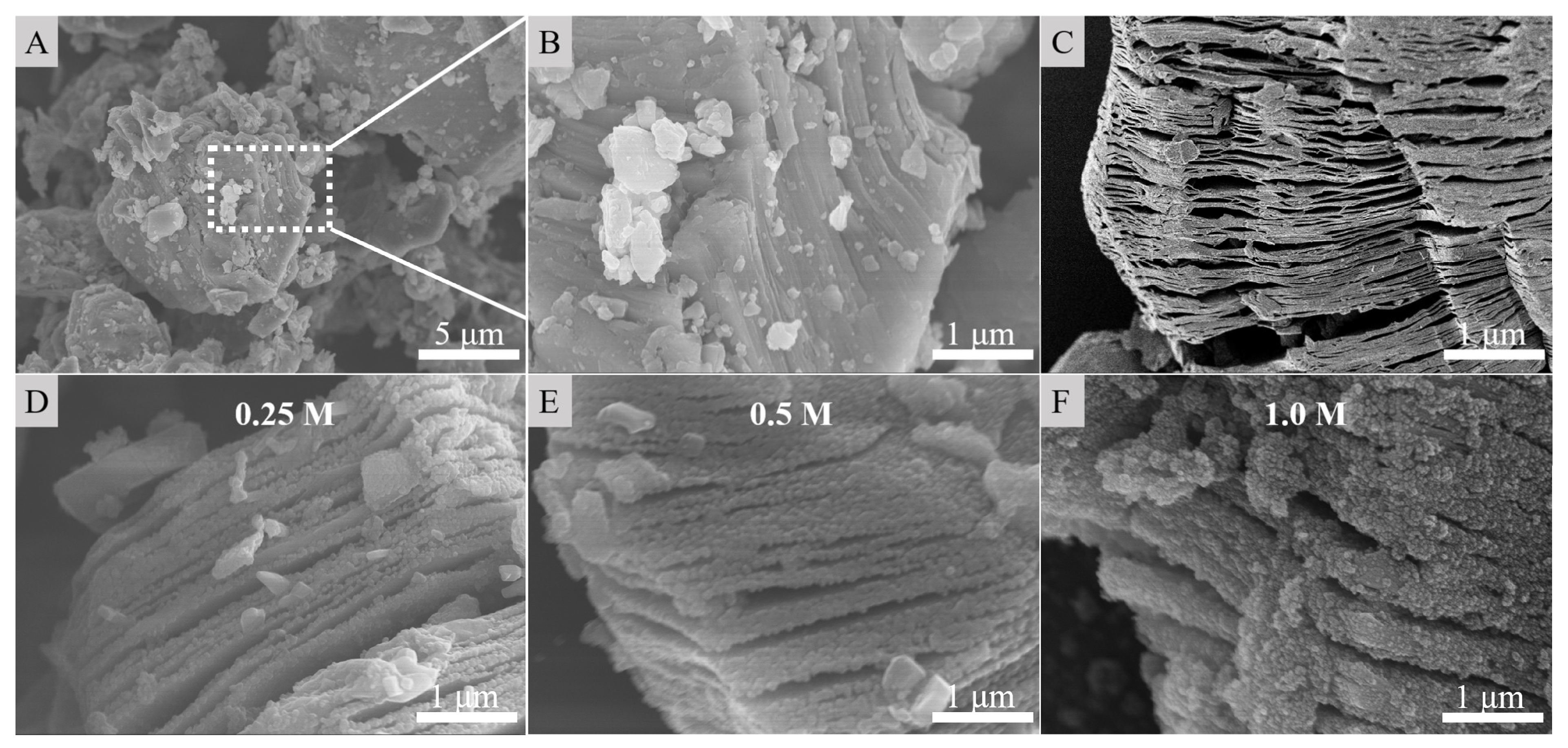

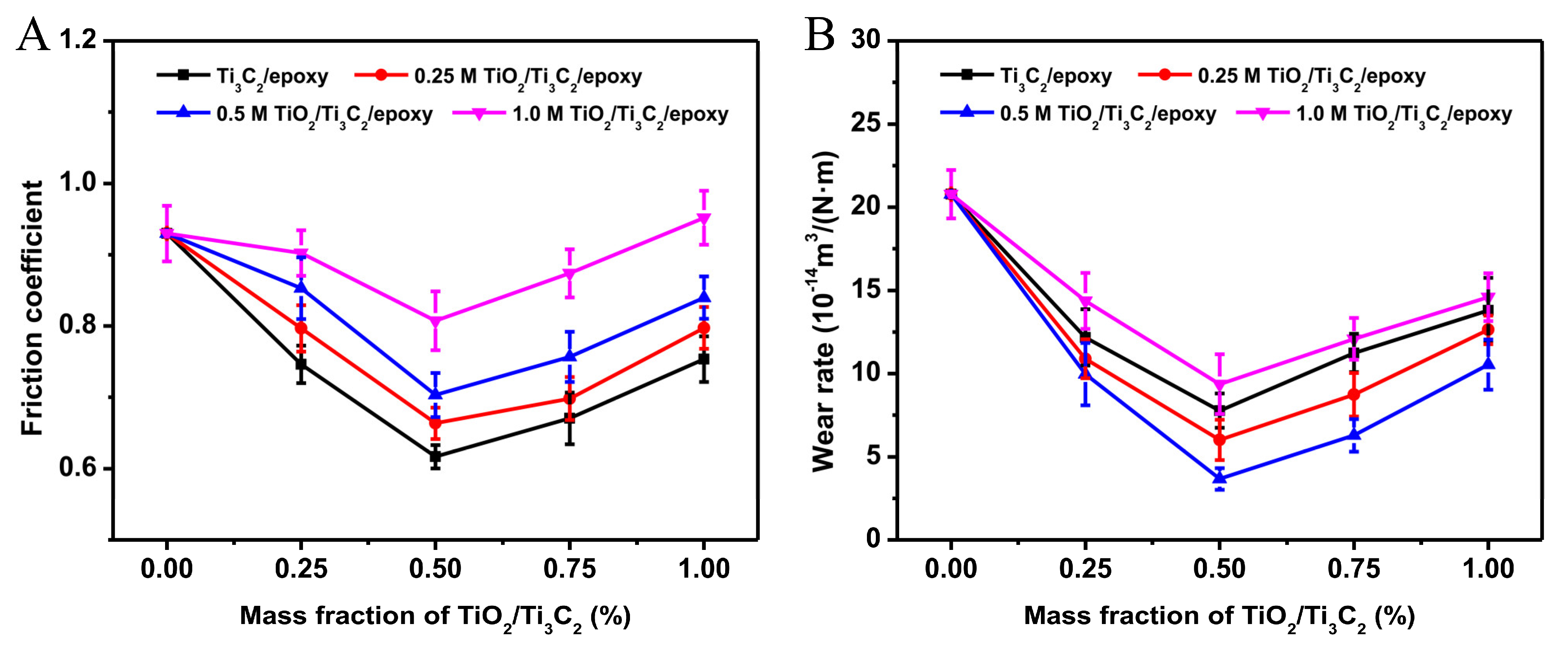
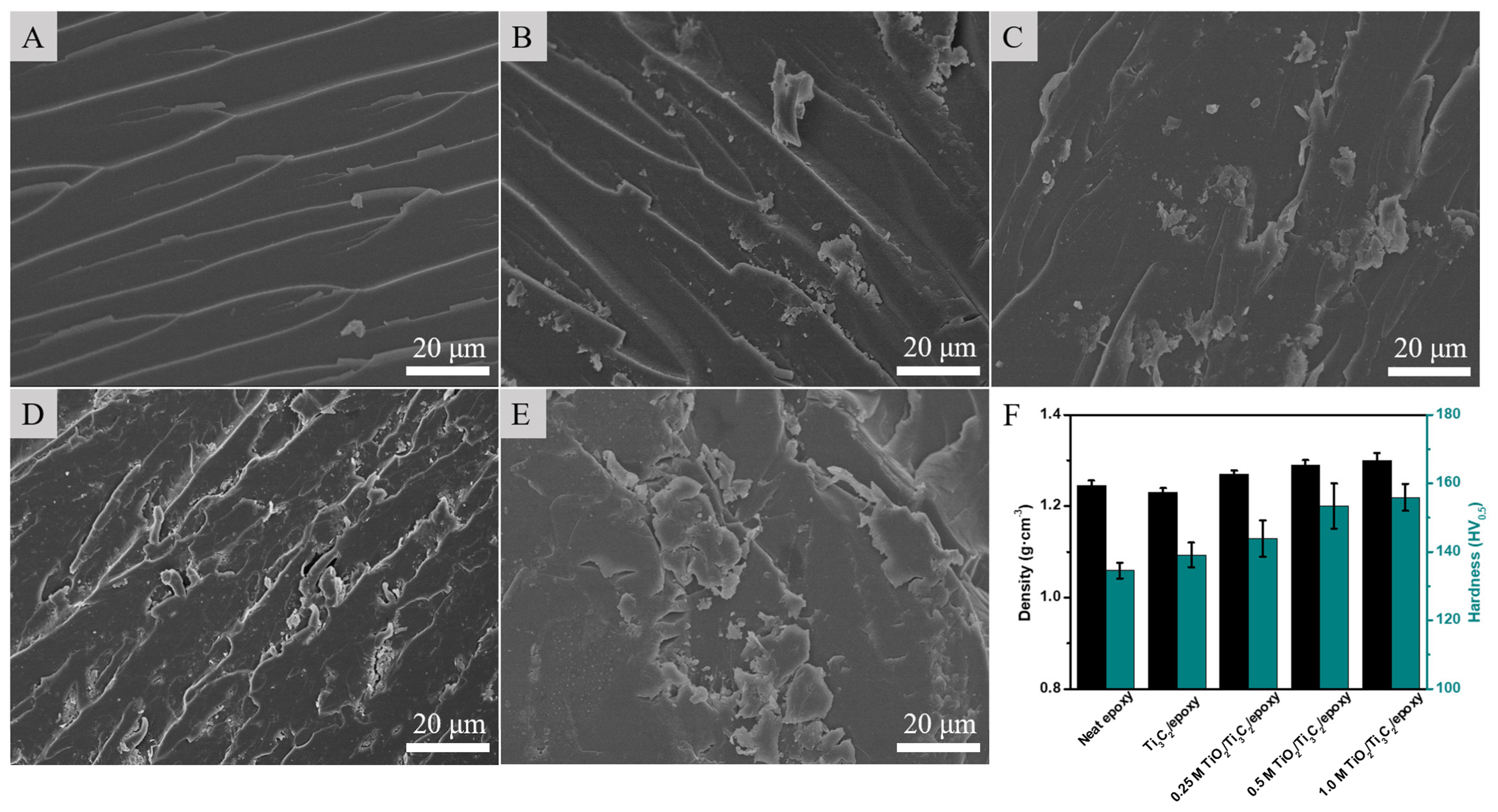
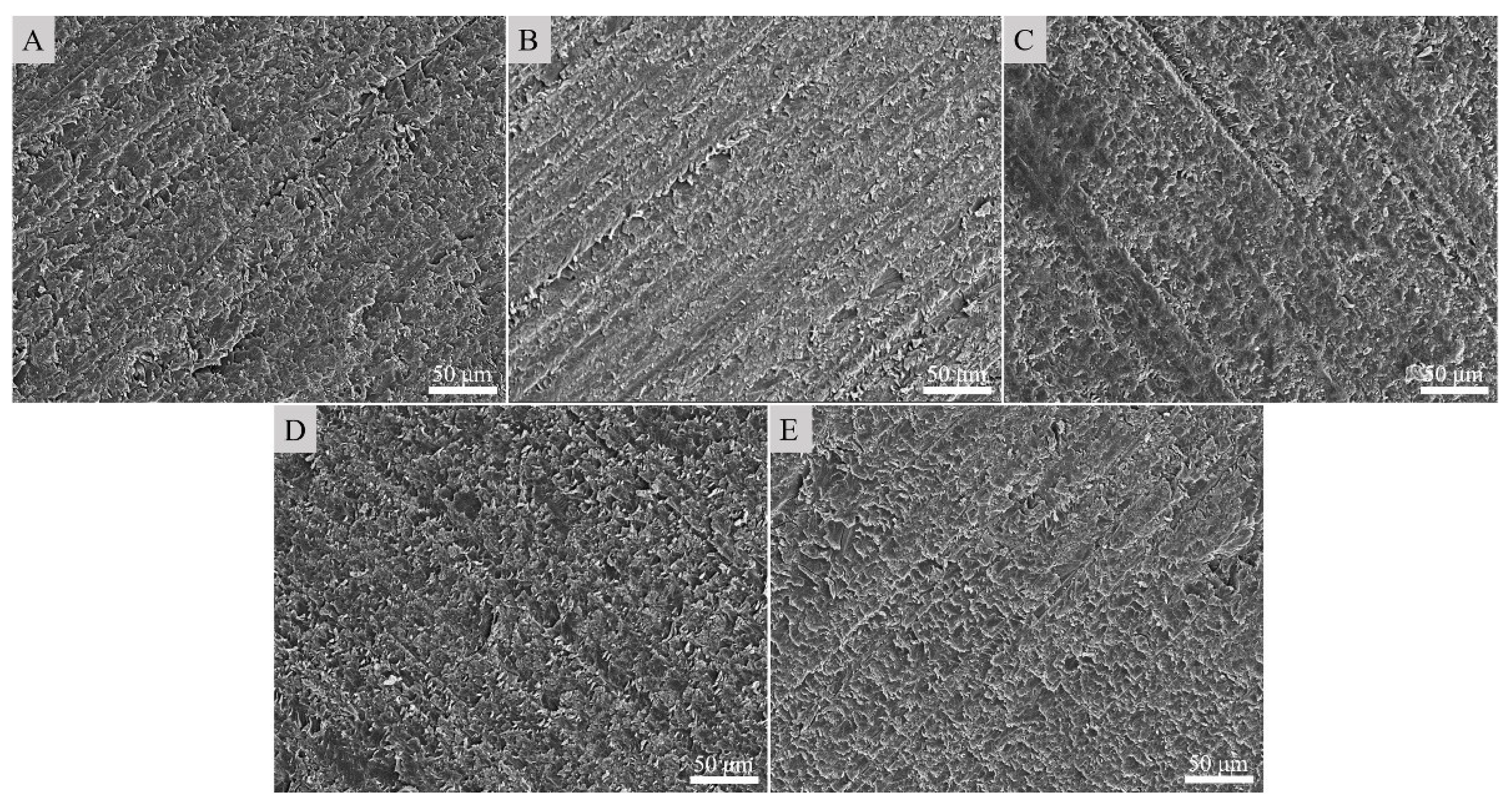

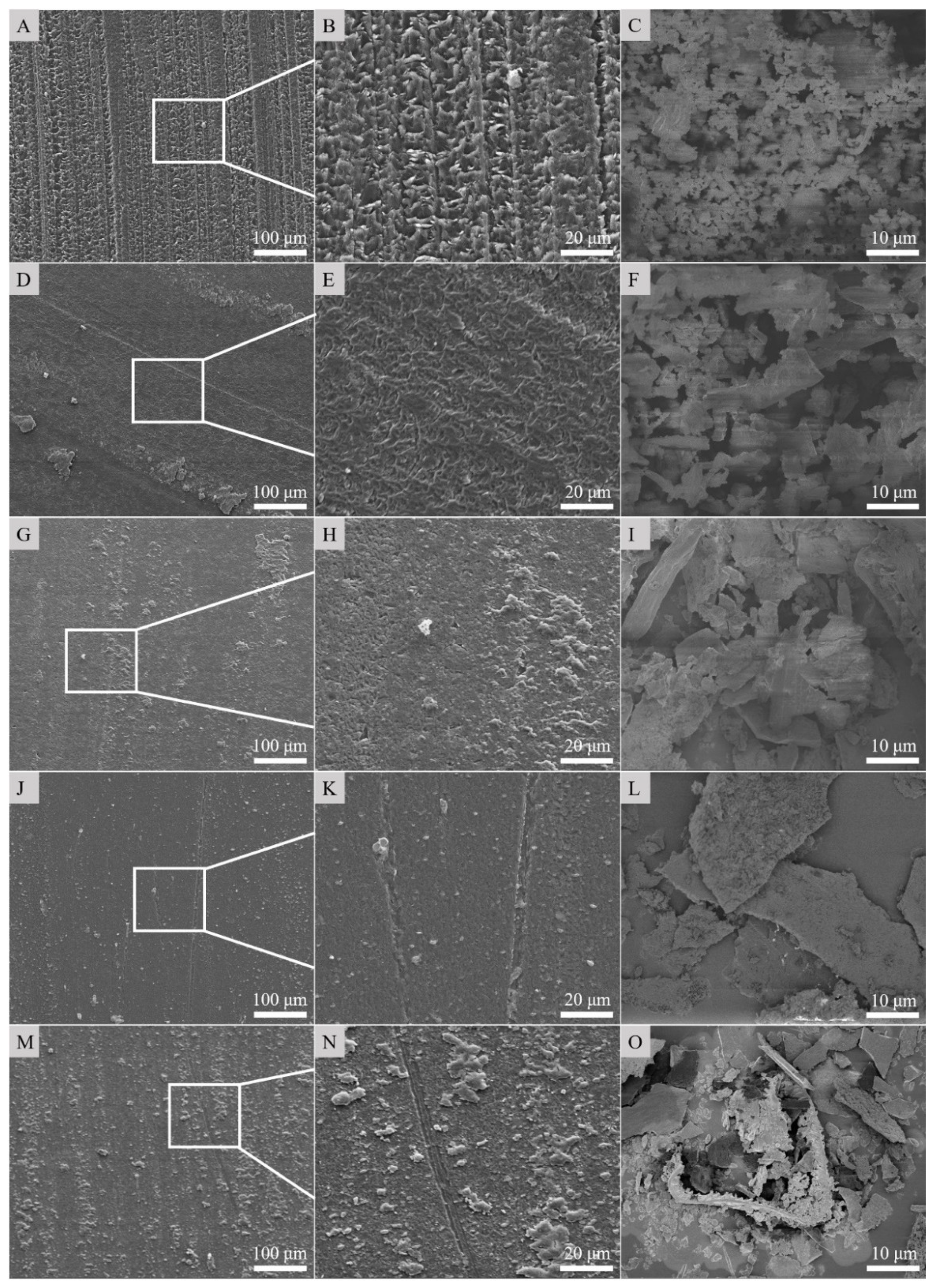
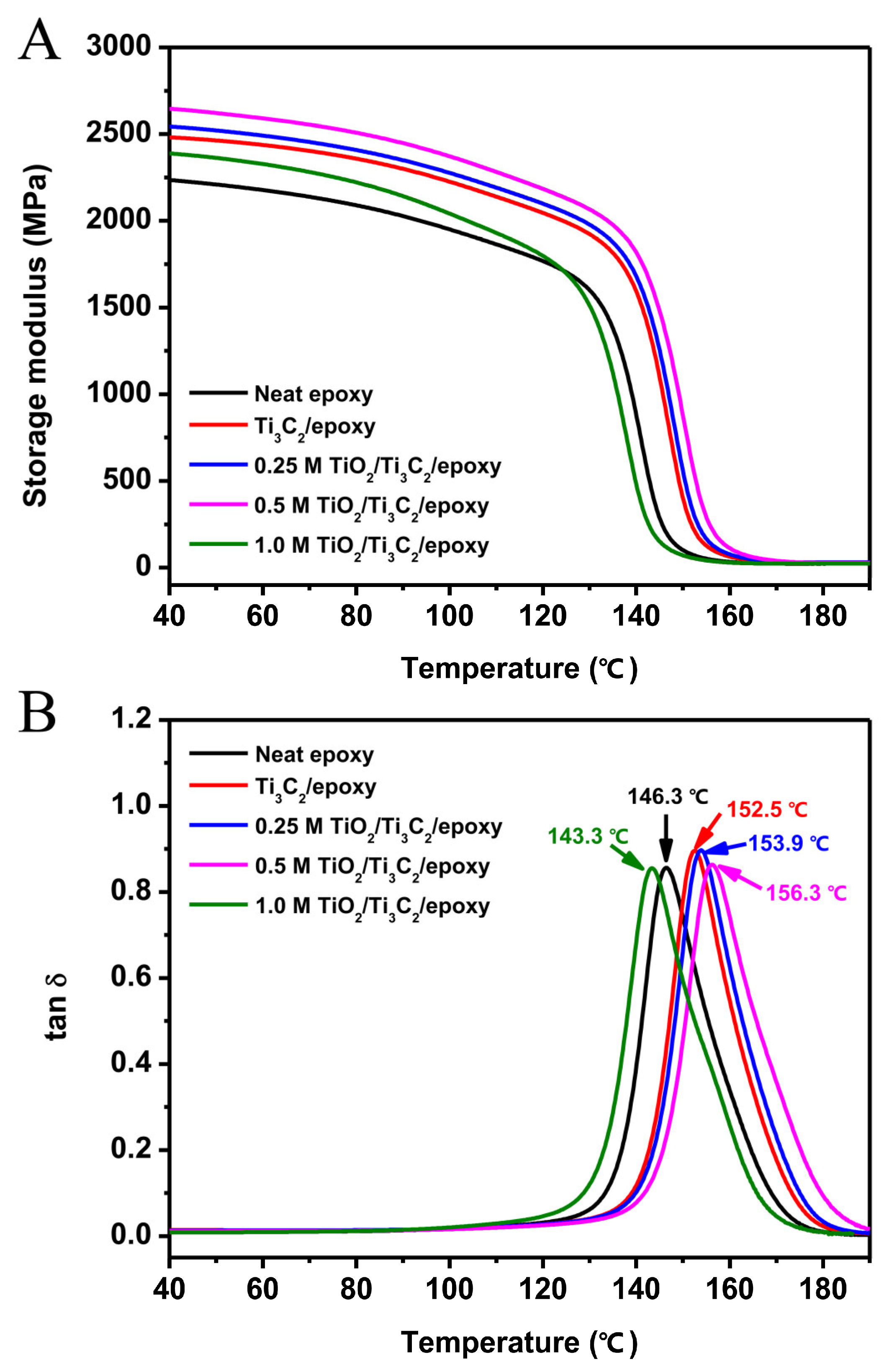
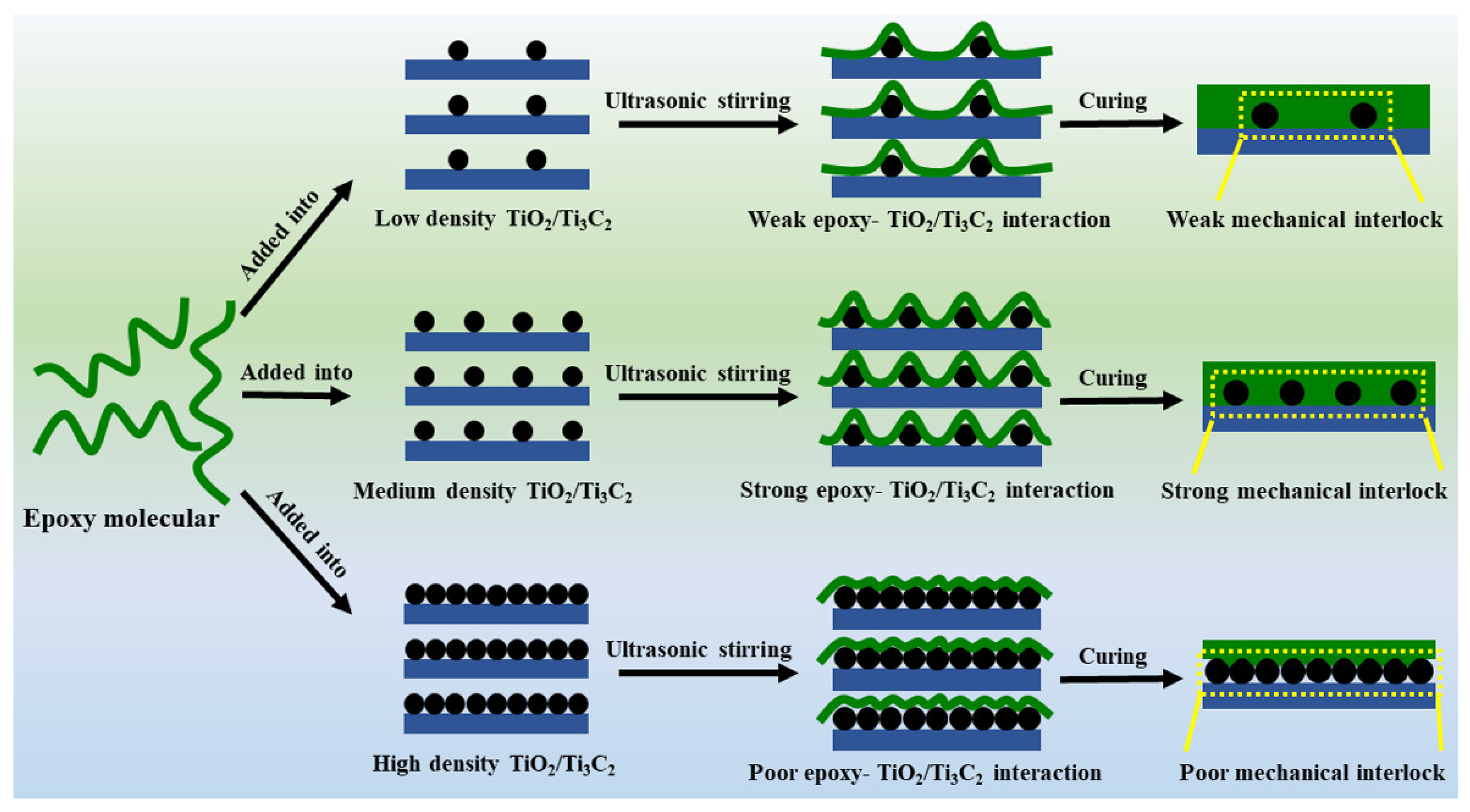
Publisher’s Note: MDPI stays neutral with regard to jurisdictional claims in published maps and institutional affiliations. |
© 2021 by the authors. Licensee MDPI, Basel, Switzerland. This article is an open access article distributed under the terms and conditions of the Creative Commons Attribution (CC BY) license (https://creativecommons.org/licenses/by/4.0/).
Share and Cite
Zhang, Y.; He, X.; Cao, M.; Shen, X.; Yang, Y.; Yi, J.; Guan, J.; Shen, J.; Xi, M.; Zhang, Y.; et al. Tribological and Thermo-Mechanical Properties of TiO2 Nanodot-Decorated Ti3C2/Epoxy Nanocomposites. Materials 2021, 14, 2509. https://doi.org/10.3390/ma14102509
Zhang Y, He X, Cao M, Shen X, Yang Y, Yi J, Guan J, Shen J, Xi M, Zhang Y, et al. Tribological and Thermo-Mechanical Properties of TiO2 Nanodot-Decorated Ti3C2/Epoxy Nanocomposites. Materials. 2021; 14(10):2509. https://doi.org/10.3390/ma14102509
Chicago/Turabian StyleZhang, Yalin, Xuzhao He, Miao Cao, Xiaojun Shen, Yaru Yang, Jie Yi, Jipeng Guan, Jianxiang Shen, Man Xi, Yuanjie Zhang, and et al. 2021. "Tribological and Thermo-Mechanical Properties of TiO2 Nanodot-Decorated Ti3C2/Epoxy Nanocomposites" Materials 14, no. 10: 2509. https://doi.org/10.3390/ma14102509




